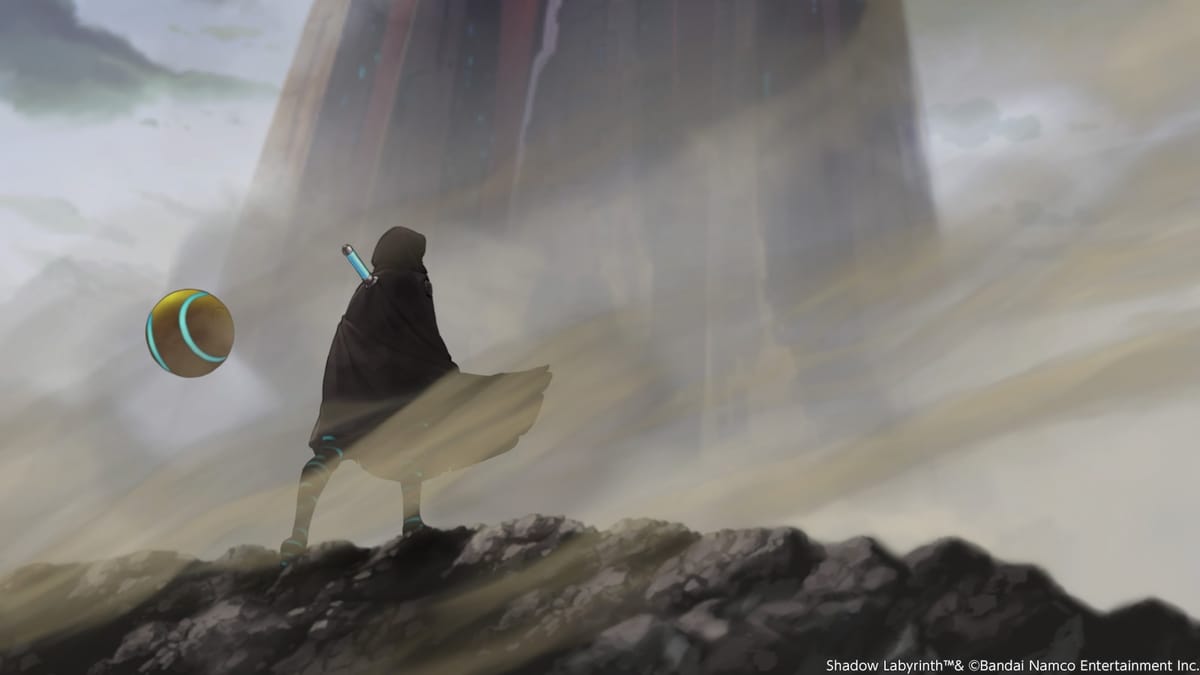
The recurring theme of my Shadow Labyrinth experience has been that it’s not what it seems. When the Secret Level anthology first introduced me to the concept of this gritter take on Pac-Man, I hated it. Yet when I ended up trying the actual game, I found that it was more than cynical shock value. It treated its inspirations with respect, it had some interesting ideas, and most importantly, it was a well-designed game. I came away from Shadow Labyrinth thinking it was the tight kind of action explorationvania game that would be great to run through in a weekend.
Shadow Labyrinth defied my expectations again by being big – about 30 hours big. Some might say that it’s Pac’d to the brim with stuff. I don’t know who. The amount of content crammed into the game is both a highlight and the source of its shortcomings. Its maps boast scale and secrets in equal measure, making for engaging labyrinths to explore even when they’re not particularly shadow-y. At times, however, it almost feels like the scope can be too grand, as levels go on longer than you’d expect or ideas that are fun in theory don’t necessarily gel together in execution. Luckily, Shadow Labyrinth celebrates Namco’s arcade history, so if there was ever a time to overindulge, it’s probably at a celebration.
While Pac-Man may be new to exploring the kinds of mazes you find in games like Metroid, I am not. Roughly ten million of these types of games come out all the time now – one probably released as you finished this sentence. While I generally love these kinds of games, I’m a bit pickier than I used to be. Simply being the kind of game Shadow Labyrinth is does not excite me; it needs solid design to back up the concept.
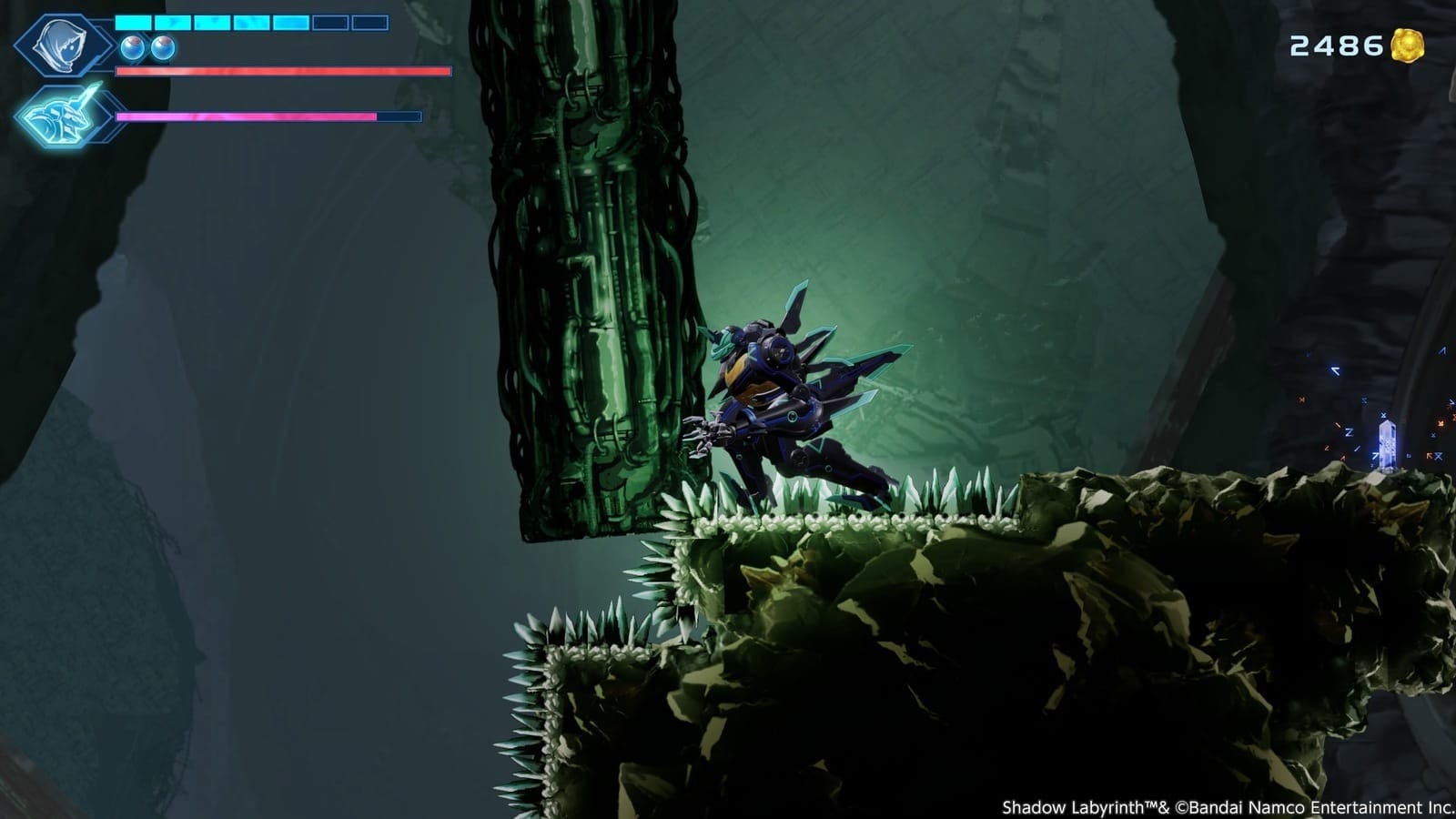
It gets the fundamentals down perfectly. Navigating around the map feels good. The map design not only holds plenty of things to explore, it does everything in its power to accommodate that exploration. The level design doesn’t bog itself down in combat or platforming challenges that can make it tedious to backtrack through, something that bothered me about the otherwise good Prince of Persia game from last year. While there are more involved platforming and combat challenges, once they are completed, they essentially stay completed without further inconveniencing you. The many unlockable shortcuts let you bypass prolonged difficult sections and smoothly get where you want to go. You can even easily navigate past enemies and obstacles if you choose, so trekking back and forth across the map never feels like a pain.
A big part of that feeling boils down to the nuances of the movement itself. While your character runs at a decent speed, you can also chain slides together to speed through areas. Your character has some momentum to his jump that takes some getting used to, but you can also manipulate your jumps with your sword slashes for some extra mid-air control to neutralize the learning curve. Combining these tactics with a dodge that lets you jump through enemies and obstacles gives you more than enough tools to quickly and efficiently traverse the map in a way that’s fun to execute.
The more I played, the more nuances I discovered. Not only can mid-air slashes help you control where you land, you can exploit them to create some extra distance in your jumps. Later into the game you acquire a grappling hook, which does surprisingly more than just let you grab certain grapple points and surfaces. If you chain it with your slashes, you can stay suspended in midair for prolonged air combat, or use it to cross crazy horizontal distances for early secrets. You can even do a little Dig Dug roleplay, if you’re into that kind of thing.
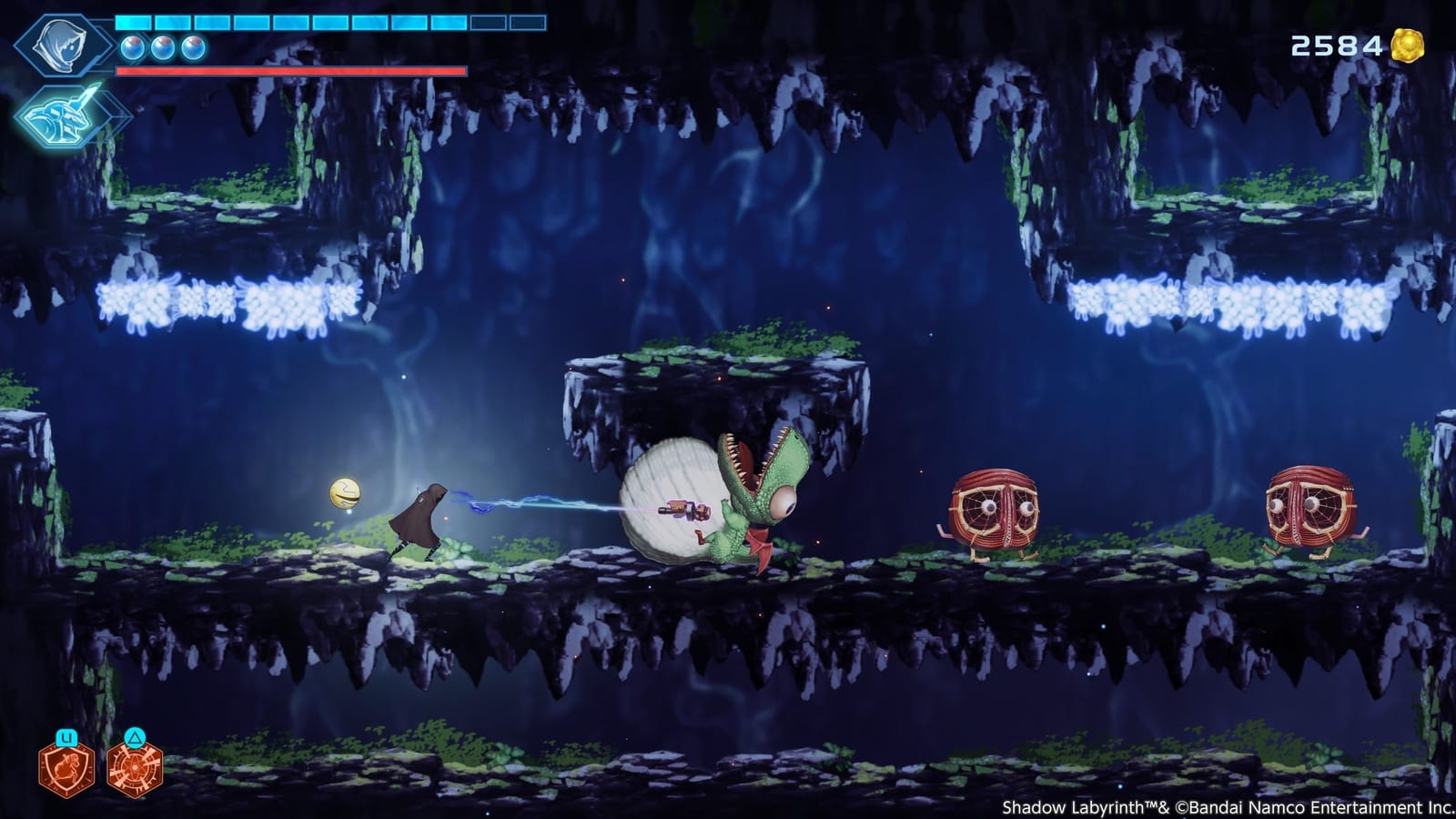
Even the combat has more to it than meets the eye. At a surface level, it’s basic – you do some sword slashes while avoiding damage with a roll tied to a stamina meter. You have a couple of health refill items that you can use in between checkpoints to make up for mistakes. You see this kind of design in everything now; I don’t need to tell you whose fault this is. I suppose if any company has earned the right to dip into the Souls well, it’s Namco. When I unlocked the parry, I mentally braced myself – here we go, the one-button-fits-all solution killing combat design. Yet that didn’t happen.
Positioning matters more than anything else in Shadow Labyrinth’s combat. Some attacks simply can’t be solved by these defensive mechanics. You have to move around, jump, and pay attention to where you’re standing to be successful. Parries won’t work right unless you position yourself correctly to take the hit. Invincibility from rolls won’t always be enough to safely carry you through attacks. Using the defense mechanics at all results in a delay that forces the player to carefully consider when to use them. In situations where multiple enemies come at you at once, parrying or dodging one isn’t always the right move because it can put you into an awkward position where you get hit by the other. Things may be simple, but there’s a fundamentally strong design sense behind them that keeps the combat engaging no matter how many times you slash through enemies.
As I fought enemies and bosses, the one thing that struck me more than anything was how no particular approach felt “forced.” Yeah, some bosses will strongly encourage you to parry their attacks, but you don’t need to and sometimes they’re more fun if you don’t. I know this because in my preview build, I fought a boss based off the pink ghost from Pac-Man without knowing that you could parry. That boss shoots various claws that can be deflected by the parry, temporarily disabling them and giving you long breathers to smack the boss around. Without the parry, I simply snuck hits in while dodging the madness of claws shooting at me, narrowly avoiding the barrage of attacks the whole time. It was awesome. Even better – it was an equally valid way to fight the boss.
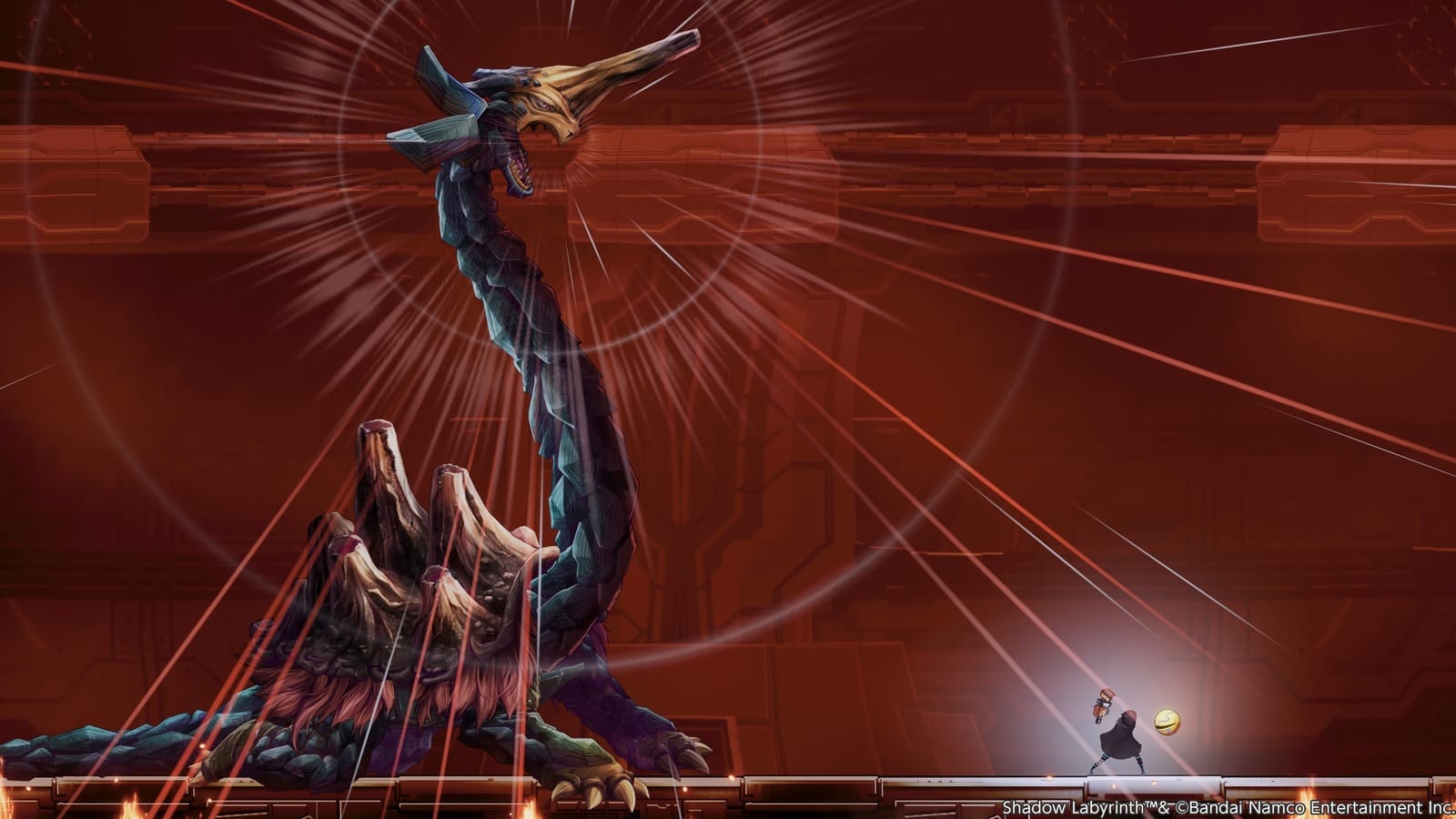
I was concerned that the ability to activate a giant mecha mode to tank damage would trivialize bosses, but in practice, it stopped being a major concern after the first handful of bosses. In most cases, the mech won’t last long enough for you to take out a significant chunk of a boss’s health, so if you do get far enough to defeat a boss with this tactic, it is probably almost dead anyway. At that point, you’ve more than likely learned the fight and earned that victory.
All of this is to say that Shadow Labyrinth is a real, well-designed video game. The premise may sound like a joke, but the game is not. It’s a challenging and thoughtfully made game that amounts to far more than just an edgy Pac-Manvania.
It’s far more than Pac-Man in particular. The Namco roots also make for some cool discoveries of their own. The way Shadow Labyrinth makes arcade legacy tangible works surprisingly well. You will believe that you can feel things about the story of Galaga, Xevious, and Bosconian by the time the game is over. Of course, the best references come from when the game directly integrates these connections into the game world itself. Whether it’s a Splatterhouse-themed area or a literal Dig Dug maze, the ways the game adapts these concepts into this style of game are consistently creative.

The most prominent integration of Shadow Labyrinth’s arcade legacy is of Pac-Man. Various sections of the game require you to transform into the classic Pac-Man puck shape to do some Pacforming. Your puck trails across Pac-Man lines eating dots as expected, except you’ll often need to hop from line-to-line, which takes some practice. At the press of a button, you can have your Pac move automatically or stay still, and both modes can be helpful as the angle of your jump seems to change based on your movement. These sections aren’t necessarily difficult, but they do take some time to adjust to.
What takes even more time to adjust to are various slabs you can activate to access special Pac-Man maze challenges to complete. These slabs transport you into what is essentially Pac-Man Championship Edition 3. I’m a big fan of 1 and 2, so that’s awesome. Like the other CE Pac-Mans, these challenges emphasize execution over the reaction-based gameplay of classic Pac-Man. You follow preset paths of dots to unlock more of each maze to try to blow through the maze as quickly and elegantly as possible. CE3 integrates the Pacforming as its mechanical twist compared to its predecessors. This works, but unlike the main game’s Pacforming, these sections are necessarily difficult.
Completing the mazes is one thing, but getting a perfect score in a maze takes more effort than even the toughest boss fight the main game has to offer. While I like CE3’s inclusion, it doesn’t necessarily gel with the exploration game, both difficulty-wise or pacing-wise. After going through a few, I found myself hesitant to fully engage with them because of the presumed time commitment. I didn’t always want to stop the game I was playing to grind out an entirely different kind of game for an hour. Each attempt is a minimum of five minutes, so if your only concern is beating the maze and moving on, they’re still a rather large diversion.
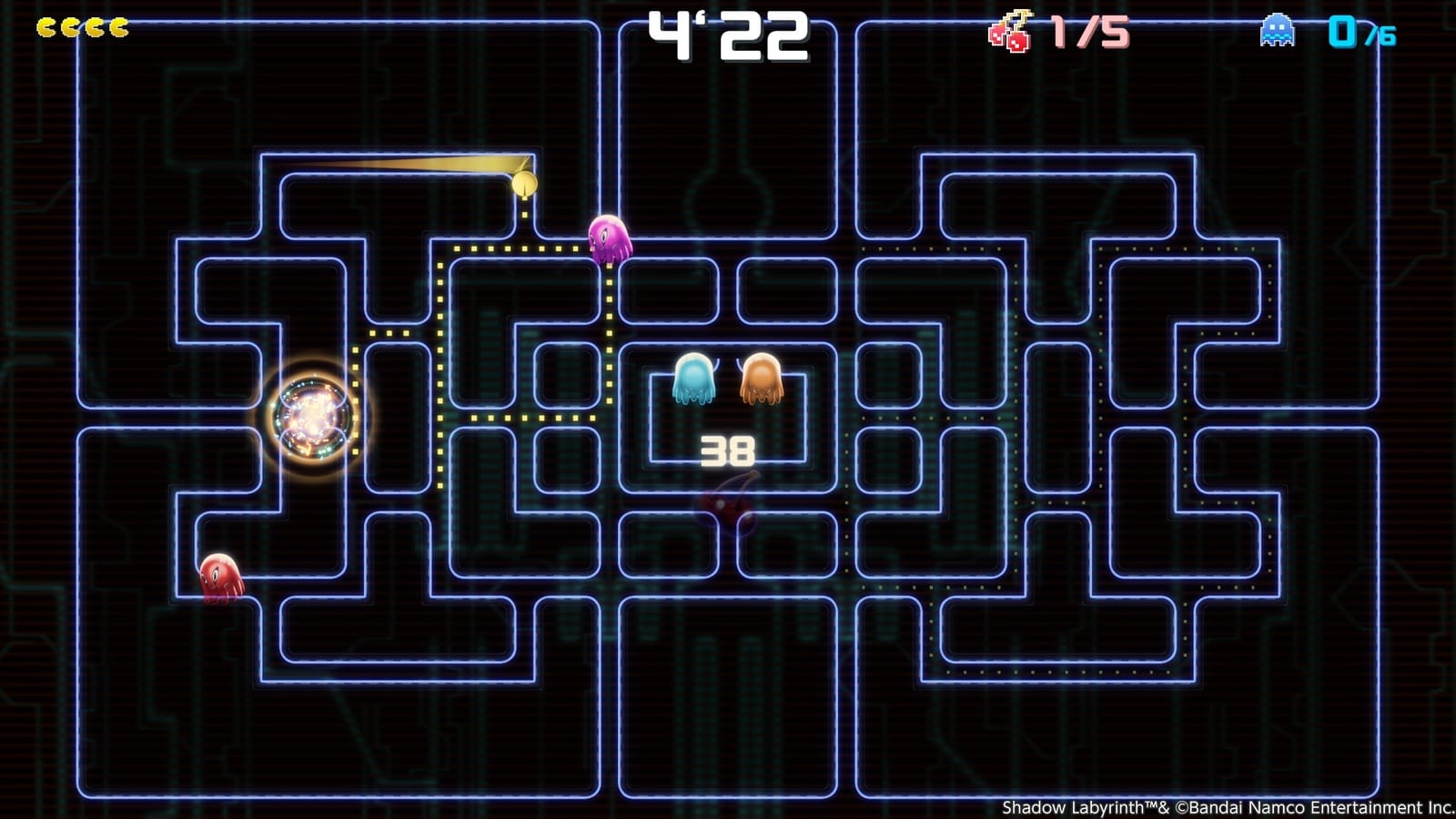
Basically, the mazes are a cool addition, yet they frequently made me think “that’s enough please, I’m ready to move on.” I would have preferred the mazes to be treated as bonus unlocks that you could select in a menu outside the game entirely. That way, I could play them at my leisure and I wouldn’t have to think of them as intruding upon the main game. As is, they’re just too different from the core experience so I wasn’t always in the mood for them.
Throughout my time with Shadow Labyrinth, I found myself having similar thoughts about a few of the individual areas as well. I enjoy how big the maps are, but some of them go on just a little too long without shaking things up much. It gets a little exhausting to complete various challenges for a security key, only to find out you need another, and then another, and then another…it’s really not even so much an issue of the game design itself so much as the framing. If you put the same content in a different context, it would likely have had a totally different psychological effect. In its current form, though, some of the maps feel like the developers crammed in more ideas than they probably should have in a few places.
Shadow Labyrinth also feels overstuffed when it comes to its RPG elements. For the most part, things are fairly tame – you can buy and unlock various skills to customize your character’s abilities. Perks can increase your health or affect your attacks and so on. What bugs me about these are less the rewards and more that so many of them are locked behind crafting materials. In order to craft a particular item or perk, you need to eat up the corpses of enemies and hope you get the right drop.
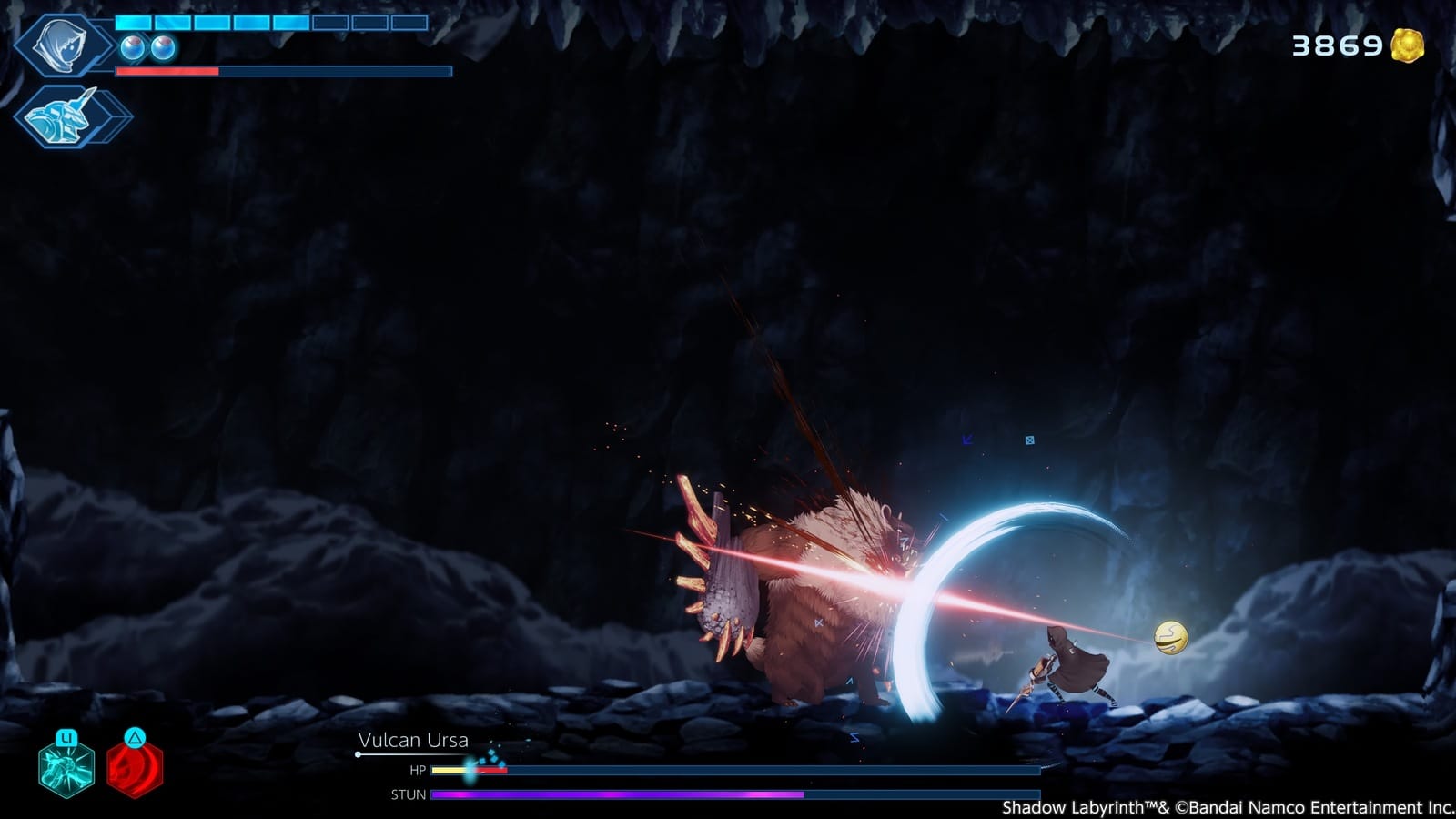
I don’t understand why exactly this concept has become so prevalent in games now. Crafting materials are not exciting item drops. They are indirect and often confusing because no normal player will understand them at a glance. To garner any amount of excitement about a crafting material, you need to already know what the material can be used for, which requires the kind of memory or attention to detail most players simply won’t bother with. People will only care about getting a specific crafting material when it becomes a problem: they want to craft something and then realize they don’t have it. This turns tracking it down a chore rather than something exciting. Playing six degrees of separation when it comes to connecting item drops to something of practical value only stuffs the game full of unnecessary padding.
I like the eating mechanic itself because it’s not an automatic thing, you have to monitor your stamina to do it and it leaves you open to attacks. That’s a cool risk-reward take on the concept a– no, I can’t do this. Even if the eating mechanic has merits, the crafting system underlying it is obnoxious. The Castlevania part of the Metroidvania equation got this right from the start: when you kill an enemy, it drops an item that you can immediately obtain value from. What a concept!
Shadow Labyrinth
Great
Shadow Labyrinth earns the right to have its darker version of Pac-Man be taken seriously. Its solid exploration and combat mechanics make for an excellent game that gets further elevated by its fun integration and celebration of Namco history into its design. While at times the game can feel a little too bloated with ideas, it’s okay to overeat during a celebration.
Pros
- Well-designed map and traversal
- Simple but strong combat
- Fun integration of Namco history
- Pac-Man Championship Edition 3
Cons
- Overstuffed in a few places
- Pac-Man CE3 is a big difficulty spike over the actual game
This review is based on a retail PS5 copy provided by the publisher.
